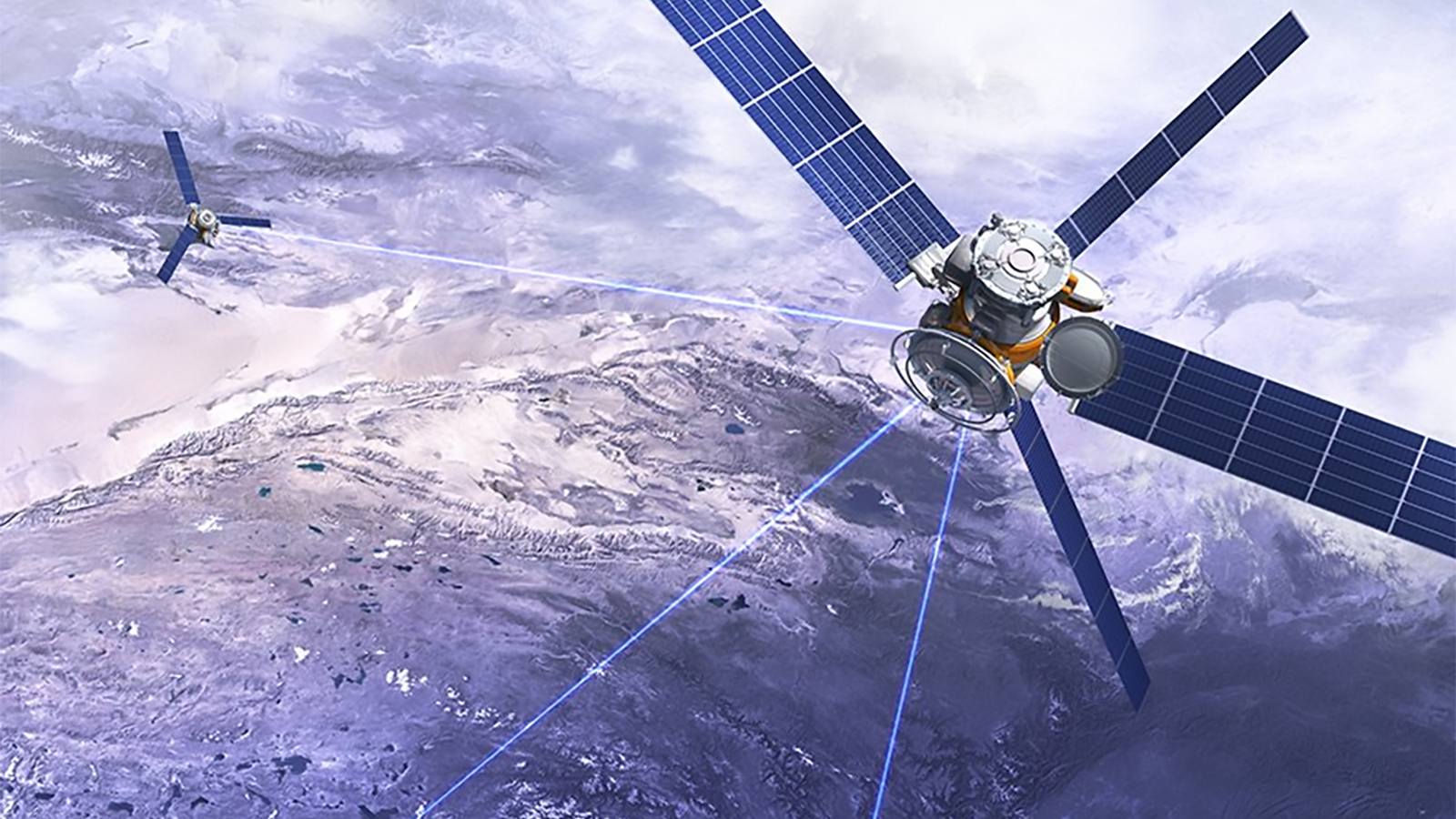
Optical links will connect SDA’s Transport Layer to weapons platforms. (SDA image)
WASHINGTON: The Space Development Agency announced a total of $1.8 billion in contracts today to York Space Systems, Northrop Grumman and Lockheed Martin for its first set of mission-capable satellites to provide high-speed, high volume data relay — a constellation that will provide the backbone for future Joint All Domain Command and Control (JADC2).
In total, the so-called Tranche 1 Transport Layer (T1TL) constellation will comprise up to 126 satellites. Under the new contracts, each company will develop and build 42 prototype satellites to be delivered in time for launch to begin in September 2024. The contract amounts, however are different: York’s contract is worth approximately $382 million; Northrop Grumman Strategic Space Systems’s, approximately $692 million; and Lockheed Martin’s, approximately $700 million.
“The T1TL will provide global communications access and deliver persistent regional encrypted connectivity in support of warfighter missions around the globe by serving as the backbone for Joint All Domain Command and Control (JADC2) built on low-latency data transport, sensor-to-shooter connectivity, and direct-to-weapon platforms connectivity,” SDA said in a press release today.
SDA’s acquisition strategy is modeled after commercial software development, rolling out a set of increasingly capable satellite versions every few years.
“Through our solicitations, we aim to create a marketplace through two-year spiral development and regular, full and open solicitations for each tranche so that industry can plan, develop and grow accordingly,” said SDA Director Derek Tournear.
The agency in 2020 awarded defense giant Lockheed Martin and relative newcomer York Space Systems contracts to each build a set of 10 satellites for the Transport Layer’s first iteration, called Tranche 0: Lockheed Martin’s contract was worth $187.5 million; York’s, $94 million. The contest for the follow-on Tranche 1 first opened last August, but was revised and re-opened in October following a bid protest by Maxar Technologies.
The original request for proposals (RFP) for Tranche 1 explained that SDA wants 126 “baseline” satellites carrying a Ka-band space-to-ground communications link, four optical communications terminals, a Link 16 payload (which is the current standard for machine-to-machine communications link among US and allied weapon systems), and a battle management, command, control and communications (BMC3) compute and storage module. Optical inter-satellite links are both the foundational tech, and the biggest challenge, for the constellation, allowing the many small satellites to bounce data from one to another on-orbit.
“This innovative mesh network of small satellites will link terrestrial warfighting domains to space sensors, allowing warfighters much faster access to data so they can stay ahead of emerging threats,” Erik Daehler, communications mission area leader at Lockheed Martin Space, said in a company release.
“Northrop Grumman recognizes information on the modern battlefield must be delivered to our warfighters at the speed of relevance,” said Robert Fleming, Northrop Grumman’s vice president and general manager, strategic space systems, in a press release today.
Chuck Beames, York’s executive chair, told Breaking Defense that once up and running, the Tranche 1 constellation “will be used in direct support” of the Combatant Commands. He explained that this marks an important shift in thinking by the national security community toward having confidence that small satellites can reliably provide mission capability.
“This was the big pivot point,” said Beames, who also chairs the SmallSat Alliance.”So, it’s a big deal for the small sat community.”
Tournear said his organization is “changing the landscape for acquisition of national defense space capabilities by capitalizing on a unique business model that harnesses commercial development” at low cost and with high speed.
SDA intends to launch the T1TL satellites sometime in 2024, as another step toward building out a new National Space Defense Architecture of new constellations in Low- and Medium-Earth Orbits, designed both to augment current military space capabilities and backup to today’s small number of highly expensive, vulnerable satellites.
The Transport Layer, in particular, is aimed at providing a new capability to link sensors on the ground, at sea, in the air and in space to “shooters” in near-real time. The data transport layer is thus “one of the key pieces” of JADC2, Space Force head Gen. Jay Raymond said last month.
At the same time SDA is moving out to create an operational capability, Space Force’s Space Warfighting Analysis Center (SWAC) is working on an overarching “force design” for the data transport layer to inform the 2024 budget cycle, SWAC Director Andrew Cox told Breaking Defense last month. That effort will look beyond the space system, he explained, for example to plan out how it will fit with existing and future sensor nodes.






















